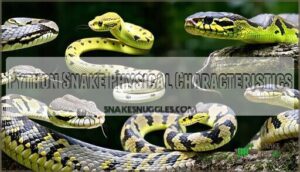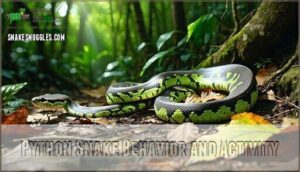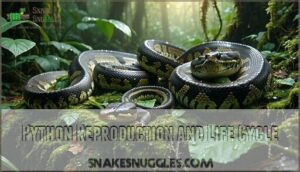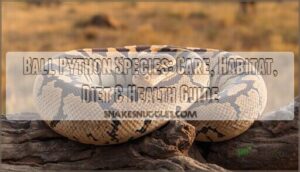This site is supported by our readers. We may earn a commission, at no cost to you, if you purchase through links.

Across continents, python species navigate tangled roots, shimmering rivers, and urban edges, leaving a deep mark on local folklore and ecosystems alike.
Whether you’re new to reptiles or keen to understand the intricacies of their world, a well-crafted python snake species guide can help you recognize, respect, and safely coexist with these complex creatures as their habitats and challenges evolve.
Table Of Contents
- Key Takeaways
- What Are Python Snakes?
- Types of Python Snake Species
- Python Snake Physical Characteristics
- How to Identify Python Species
- Python Habitats and Geographic Range
- Python Snake Behavior and Activity
- Python Diet and Hunting Techniques
- Python Reproduction and Life Cycle
- Python Snakes as Pets and in Captivity
- Conservation Status and Threats to Pythons
- Frequently Asked Questions (FAQs)
- What is a python snake?
- How many Python snakes are there?
- How many types of pythons are there?
- Where do python snakes live?
- What is the scientific name for a Python?
- Are pythons common in New Guinea?
- Are python bites dangerous to humans?
- How do wild pythons interact with other animals?
- What diseases can pythons carry or transmit?
- Do pythons face predators in the wild?
- Conclusion
Key Takeaways
- Python snakes come in many species, each with unique behaviors, habitats, and appearances that help them adapt and survive in diverse environments.
- Identifying python species relies on careful observation of features like size, coloration, scale patterns, and head shape.
- Pythons play a vital role in their ecosystems but face threats from habitat loss, the pet trade, and human encroachment.
- Providing proper care, understanding their natural behaviors, and respecting legal and ethical considerations are essential for keeping pythons as pets.
What Are Python Snakes?
Pythons come in different shapes, sizes, and personalities, and each species has its own way of living. If you’re thinking about where they stay, it’s important to know the basics before you look at your options.
Let’s check out the main types of enclosures you might consider for keeping a python comfortable and safe.
Python Family Overview
When you picture pythons, think of a family tree packed with powerful, non-venomous snakes that have mastered the art of the squeeze.
The Pythonidae family shows considerable subspecies diversity and unique adaptations—ranging from small, burrow-loving species to giants like the reticulated python.
These snakes share classic Pythonidae traits, reflecting deep evolutionary relationships built on specialized hunting and distinctive body structures.
Classification and Taxonomy
Knowing how each python fits into the big family picture starts with understanding their place on the scientific tree of life. Python classification and taxonomy address questions like:
- How do genetic diversity and evolutionary history shape Family Pythonidae?
- Snake classification often stirs subspecies debate and discussions on hybridization potential.
- Ongoing taxonomic revisions keep reshaping our understanding of python species classification.
Types of Python Snake Species
Pythons come in a surprising variety, each with its own traits and quirks. Some are well-known giants, while others are more modest and secretive.
Here’s a look at the main types you’ll come across.
Children’s Pythons (Genus Antaresia)
If you’re curious about pythons that stay small, the Children’s pythons offer a perfect example of how nature sometimes keeps things compact and intriguing. This group—Antaresia—includes the pygmy python and spotted python, both well-known among Australian pythons for their manageable size differences and gentle temperament.
Their straightforward enclosure design, simple Antaresia care, and interesting breeding habits make them appealing options when considering a python as a pet.
Shield-bearing Pythons (Genus Aspidites)
Switching gears from the pint-sized Antaresia, let’s talk about the rugged shield-bearing pythons of Australia’s wild heart. These Aspidites—blackheaded pythons and womas—stand out for their distinctive scale adaptations, essential desert habitat survival, and fascinating thermoregulation behavior. Here’s what you should know:
- Unique shield scales aid identification
- Thrive in arid landscapes
- Blackheaded python distinct coloration
- Woma’s burrowing lifestyle
- Conservation challenges persist
Whitelip Pythons (Genus Bothrochilus)
With a glimmer of iridescence along their lips, whitelip pythons bring a bit of the rainforest’s shimmer right into view. Both the Southern Whitelip and Northern Whitelipped Python boast bold coloring, curious temperaments, and unique color morphs.
For Bothrochilus care and successful captive breeding, focus on secure enclosure design. Careful python identification separates these striking species from lookalikes.
Genus Leiopython
Leiopython snakes, better known as white-lipped pythons, stand out for their sleek bodies and striking metallic sheen. These notable snake species thrive in humid forest edges, often near water. Accurate python identification relies on cueing into their vibrant iridescence and sturdy heads. If you’re curious, keep these highlights in mind:
- Distinctive high-gloss scales
- Moderate size and muscular build
- Varied Leiopython habitat preferences
- Stable conservation status, yet limited captive care resources
Genus Apodora
Meet Apodora, a genus best known for the enigmatic Papuan olive python—a snake whose subtle strength and olive sheen can turn heads in its rugged island home.
Apodora taxonomy highlights just one species, often called D’Albertis python, native to Papua New Guinea. Its muscular build, shifting hues, and flexible diet set it apart among snake species and habitats—a rare conservation priority.
Key Species Profiles (Burmese, African Rock, Reticulated, Indian)
Ever wonder how the Burmese python measures up against the African rock python, reticulated python, and Indian python? Size comparison shows all are giants, but the reticulated python takes the crown.
You’ll find habitat overlap in wild regions, yet invasive impacts and conservation challenges remain ongoing. Reticulated pythons are known to inhabit lowland rainforests.
In captivity, these Python species demand expert care and respect for their powerful nature.
Python Snake Physical Characteristics
When you look at a python, there’s a lot more going on than just size and color. Every species has its own set of traits that set it apart.
Let’s take a closer look at the physical features you’ll notice in each type.
Size and Length Variations
From tiny hatchlings that can fit in your hand to giants stretching more than twenty feet, pythons truly show that regarding size, these snakes have set their own rules.
Among python species, snake sizes differ for several reasons:
- Growth rate factors: food, climate, and genetics.
- Sexual dimorphism—females often outgrow males.
- Captivity vs. wild—captivity sometimes boosts maximum recorded lengths.
Coloration and Pattern Differences
Take a closer look at a python’s skin, and you’ll find a living mosaic of colors and shapes that’s as unique as a fingerprint. Pattern mimicry and scale iridescence help with snake camouflage and coloration, while regional variations, melanism, albinism, and ontogenetic shifts shape python coloration and patterns.
These traits make identifying python species a fascinating study in adaptation.
Anatomy and Body Structure
Beneath those colorful patterns, every python is built for strength and stealth, with a body design that tells a story as much as its skin. A python’s muscular system coils around a sturdy skeletal structure.
Their elongated torso houses specialized sensory organs and powerful internal organs. This reptile anatomy bolsters impressive size and appearance—showcasing distinctive python snake characteristics and sophisticated scale morphology.
Unique Features (Scales, Head Shape)
When you take a closer look, a python’s shimmering scales and broad head set them apart from just about any other snake. Each species varies in scale morphology and head proportions, offering key clues for python identification.
You’ll notice:
- Heat-sensing pits (sensory pits) along the jaw
- Distinctive pattern uniqueness for each individual
- Sturdy head shape—an evolutionary adaptation for swallowing large prey
How to Identify Python Species
Spotting the differences between python species isn’t always as tough as it seems. You’ll want to pay close attention to patterns, colors, and a few key features. Let’s look at what sets them apart so you can tell one from another.
Visual Identification Tips
Spotting the differences between python species starts with knowing what details to look for in their patterns, colors, and shape. Pay attention to scale patterns and head morphology—these give big clues in python identification.
Python size and appearance, alongside color variations and juvenile markings, often hint at snake coloring or regional differences, helping you nail down specific python physical characteristics.
Distinguishing Similar Species
So, you’ve noticed the details—now let’s separate lookalikes. Snake identification between different python species means zeroing in on:
- Scale Count at midbody,
- Head Morphology (triangular vs. rounded),
- Pattern Analysis (net-like vs. blotchy),
- Hybrid Identification cues,
- Range Overlap in known habitats.
These snakes are efficient ambush predators, relying on stealth to capture their prey. Mastering Python identification and characteristics really is a hands-on art.
Common Misidentifications
Even experienced snake spotters can mix up a harmless python with a dangerous species if the lighting is bad or stress levels run high. Similar markings and size confusion with other snake species—especially in areas with geographic overlap—can throw you off.
Harmless look-alikes may copy the behavior clues of pythons. Careful snake identification always means considering both habitat and distinct python identification and characteristics.
Python Habitats and Geographic Range
Pythons can be found in all sorts of places, from steamy forests to sunbaked grasslands. Where each species calls home shapes everything about its lifestyle.
Here’s a closer look at the main habitats you’ll want to know about.
Asian Python Species
Did you know that Asia is home to some of the world’s largest and most colorful pythons, each thriving in jungles, grasslands, and even bustling farmlands? Look closer and you’ll find:
- Reticulated pythons winding through Southeast Asia’s rainforests
- Indian pythons in rocky grasslands
- Burmese pythons near rivers and fields
- Smaller island pythons adapting to unique local conditions
African Python Species
Step into Africa’s wild places and you’ll find pythons as bold as the landscape itself, from sun-baked savannas to tangled riverbanks. The African Rock Python (Python sebae) stands out for its sheer size and striking behavior patterns. Curious about key facts? Explore below:
| Species | Habitat Type | Conservation Status |
|---|---|---|
| African Rock | Savannah, riverbanks | Not Threatened |
| Ball Python | Grasslands, forests | Near Threatened |
| Royal Python | Wooded edges, scrub | Stable |
| Angolan Python | Rocky slopes | Data Deficient |
| Southern Rock | Floodplains, marshes | Least Concern |
Australian Python Species
Australia’s python scene is like no other, with snakes that rule sunbaked deserts and lush rainforests alike. Australian python species such as the Olive Python, Water Pythons, and Carpet python display striking unique adaptations.
Keen on detail? Consider these highlights:
- Spotted python and Children’s pythons thrive in rocky outcrops
- Varied habitat regions test survival skills
- Conservation challenges continue for many
Island and Rainforest Habitats
Picture a world where pythons glide through emerald rainforests and slither silently across remote island floors, mastering habitats as varied as drifting clouds. In dense canopy or far-flung islands, each unique species adapts, often overlapping with rivals.
These tropical ecosystems test survival. Conservation challenges rise as human activity pressures these python snake habitats, highlighting the fragile richness of rainforest environments and island adaptations.
Adaptations to Environment
How do pythons adapt to change so well? These snakes excel through Thermoregulatory Behavior, shifting habitat and basking for warmth; Metabolic Adaptations, fueling powerful bursts after meals; and Camouflage Patterns that keep them hidden in tropical ecosystems.
- Change color to hide
- Move between habitats with ease
- Sense prey even in the dark
Each adaptation helps them thrive.
Python Snake Behavior and Activity
Understanding how pythons behave can help you care for them safely and confidently. From how they move to the ways they communicate, each species shows its own rhythms and instincts.
Let’s take a look at the behaviors you might see.
Nocturnal Vs Diurnal Activity
When the sun dips low or the night deepens, you’ll start to discover which snake prefers the shadows and which lingers in the fading light. Most pythons are nocturnal hunters, relying on specialized sensory adaptations for tracking prey at night. Their sleep patterns, body temperature needs, and hunting times shift with seasons, illustrating a fascinating range of snake behaviors and animal activity rhythms.
| Activity Pattern | Python Example |
|---|---|
| Nocturnal | Ball Python |
| Diurnal | Children’s Python |
| Flexible | Reticulated Python |
| Influenced by Temperature | Olive Python |
| Seasonal Shifts | African Rock Python |
Movement on Land and Water
After a busy night on the hunt, these snakes show off just how well they can slither across grass, twist through brush, or slip into water without missing a beat.
Terrestrial locomotion is efficient and surprisingly quick; some pythons climb with ease too. Their movement efficiency—whether swimming, climbing, or gliding over ground—reflects their aquatic adaptations, arboreal movement, and the diverse habitats shaping python snake behavior.
Social Behavior and Communication
Out in the wild, a python usually spends time alone, but these snakes still have clever ways to send messages and respond to the world around them. Through chemical signals, especially during mating rituals, they find partners and mark territory.
In captivity, you’ll see changes in captive behavior—including dominance displays and subtle postures—which reflect a simple social hierarchy and shifting animal behavior.
Camouflage and Defense Mechanisms
Even the most solitary snakes need a few tricks up their scales, and for pythons, blending in and staying defended is more art than accident. Pattern mimicry and scale iridescence help them disappear among leaves or rocks. Defensive musk and thermal camouflage throw off threats. Combined with behavioral defenses, python behavior and adaptations let these snakes hunt, hide, and survive anywhere—even for arboreal species.
Python Diet and Hunting Techniques
Every python needs food that fits its size and instinct. These snakes have clever ways of hunting and eating that help them survive.
Here’s what to know about their typical meals and how they get them.
Typical Prey (Mammals, Birds, Reptiles)
Ever wonder what’s on the menu for these master hunters? Pythons target small mammals—think rodents and rabbits—as their go-to meal, showing impressive Mammal Consumption skills. Bird Predation is common too, especially for tree-dwelling species. Some also include reptiles in their diet.
Prey animals vary in size, but each choice highlights the adaptability of the python snake diet and feeding habits.
Constriction and Feeding Behavior
With a sudden tightening embrace, these snakes turn dinner time into a dramatic display of strength and patience. Python behavior and prey interaction rely on precise constriction technique: muscles coil, cutting airflow swiftly.
Gape size lets them swallow animals far larger than their heads. Their digestion process works slowly, so feeding frequency is low, shaped by both prey selection and impressive constricting abilities.
Hunting Strategies and Sensory Adaptations
If you watch closely as dusk settles, you’ll notice these snakes rely on more than just brute force—their sharp senses and clever tactics make them masters of the hunt. Heatsensing labial pits detect warm prey, and a keen sensory network hones in on movement.
With precise ambush tactics and swift strike speed, pythons use constriction force for efficient prey detection and capture.
Python Reproduction and Life Cycle
Understanding how pythons reproduce and grow will help you provide the best care for them. Their life cycle has a few key stages that every keeper should know.
Let’s break down what happens from mating to adulthood.
Mating and Egg-Laying
You might be surprised to learn that female pythons lay dozens of eggs at a time, setting the stage for their offspring in a hidden spot away from prying eyes. Before this, intricate courtship rituals occur.
Clutch size varies by species and habitat. Incubation temperature plays a key role in python reproduction and life cycle, influencing successful egg incubation.
Parental Care and Incubation
Few scenes in nature match the quiet determination of a mother python coiled tightly around her eggs, shielding them with her own warmth until they’re ready to hatch. She’ll select a safe nest site, maintain egg temperature with maternal shivering, and guard against danger. Her dedication during the incubation period gives hatchling survival an edge in the python breeding and reproduction cycle.
- Silent sacrifices hidden beneath leaves.
- Shivering to keep each egg alive.
- Waiting out the incubation period patiently.
- Every heartbeat a promise of future life.
Growth and Lifespan
Every inch a hatchling gains is a small victory on its long journey from fragile egg to formidable adult. In the wild, juvenile snakes may double their length each year, while captive pythons often grow faster due to abundant food. Lifespan varies—some reach 20–30 years. Here’s a quick glance at growth and lifespan:
| Stage | Key Facts |
|---|---|
| Hatchlings | Rapid Hatchling Growth; fragile, escape predators |
| Juvenile | Gains in Python size and length; learning to hunt |
| Adults | Maturity Timeline completes; reproductive age reached |
| Wild | Lifespan Factors: habitat, food, predation—typical Wild Lifespan |
| Captivity | Captivity Longevity often exceeds wild; consistent care matters |
Python Snakes as Pets and in Captivity
Bringing a python into your home takes planning and responsibility. The right enclosure can make all the difference in your snake’s health and happiness.
Here’s what to know about the main types of setups available.
Popular Pet Species
A handful of python species have made a name for themselves as favorites in the pet world, thanks to their unique looks and manageable temperaments. Ball pythons and Children’s pythons are often chosen by beginners for their docile nature and simple feeding habits.
You’ll also hear keepers discuss temperament concerns, enclosure size, and care practices—central to Python care and care practices for pet snakes.
Care Requirements and Enclosure Needs
Getting a python settled in your home starts with meeting its need for the right space, warmth, and a few creature comforts.
For healthy python care and interaction, focus on:
- Proper enclosure size for movement and security
- A temperature gradient for digestion and comfort
- Humidity levels that match the species’ needs
- Substrate choice and enrichment needs to encourage natural behaviors
Legal and Ethical Considerations
Before you fall in love with the idea of keeping a python, it’s worth pausing to look at the laws and responsibilities that come with sharing your home with one. Pet ownership laws, python snake legal protection, and antitrafficking measures vary widely.
Ethical breeding practices matter too. Consider the invasive species impact, conservation funding needs, and ongoing public safety risks surrounding the wildlife trade.
Conservation Status and Threats to Pythons
Protecting python snakes means understanding the risks they face in the wild and in captivity. Some threats are obvious, while others are easy to overlook.
Here’s what you should know about their current situation.
Habitat Loss and Human Encroachment
Picture a forest shrinking inch by inch—now imagine what that means for a python searching for a place to hide, hunt, or simply stretch out under the sun. Habitat loss from deforestation, urban expansion, and agricultural encroachment pushes these snakes into risky territory, driving population decline. Climate change only worsens the challenge, making conservation strategies urgent:
As forests vanish, pythons struggle to find shelter and survive, their fate tangled with shrinking habitats and mounting environmental threats
- Fewer safe nesting or basking spots threaten young snakes’ survival.
- Deforestation impacts disrupt food webs, limiting available prey.
- Urban expansion brings pythons closer to threats and predators.
- Habitat fragmentation complicates movements, straining genetic diversity.
Pet Trade and Population Decline
Although pythons often appear in pet shops, the booming pet trade and lax Trade Regulation create real challenges for wild populations. Every python sold as a pet—or released into new habitats—affects broader ecosystems.
Invasive Impacts, poor Welfare Standards during transport, and opaque wildlife trade practices complicate Population Assessments and fuel ongoing Python snake population decline, raising pressing Ethical Concerns for conservation.
Conservation Efforts and Protection
While habitat preservation anchors python snake conservation efforts, protection goes far beyond saving wild places. Stronger trade regulations, rescue and rehabilitation programs, and science-based monitoring support struggling populations.
Across Asia, Africa, and Australia, public engagement campaigns encourage safe coexistence, while ongoing research refines wildlife preservation strategies to safeguard python species and broader reptile conservation.
Interesting Facts and Records
How does a python top the charts of snake trivia? Beyond their stealthy moves, these creatures break records in reptile circles. Here are four facts that’ll deepen your understanding of python species, behavior, and biology:
- Longest Snake: Reticulated python, over 30 feet.
- Swallow Capacity: Prey bigger than their heads.
- Anaconda Strength: Mass over length.
- Ancient Origins: Fossils date to dinosaurs.
Frequently Asked Questions (FAQs)
What is a python snake?
Bigger than most legends, python snakes belong to the non-venomous Snake family, Pythonidae. These powerful constrictor snakes rely on muscle, not venom, to subdue prey.
Pythonidae traits set python species apart from other Snake species worldwide.
How many Python snakes are there?
Recent taxonomic revisions recognize ten distinct Python species, though discoveries and hybridization events still occur. Cryptic species and changing classification of pythons highlight how population estimates and types of Python snakes shift as our understanding deepens.
How many types of pythons are there?
Experts usually recognize ten main Python species, though ongoing discoveries, hybridization events, and subspecies debates mean the true tally could shift.
Naming conventions and cryptic species add complexity, making snake species identification an evolving field within species diversity studies.
Where do python snakes live?
Spread from Africa’s grasslands to Southeast Asia’s rainforests, these snakes thrive in deserts, dense forests, and even swamps.
Habitat diversity shapes python distribution, with some species evolving on isolated islands through unique environmental adaptations, expanding their migratory range.
What is the scientific name for a Python?
Scientists group pythons under the Family Pythonidae, with most true pythons belonging to the Genus Python. For example, the Burmese python’s scientific name is Python bivittatus.
Species nomenclature often sparks subspecies debate in snake identification and taxonomy.
Are pythons common in New Guinea?
Spotting a Papuan Olive Python sliding through a New Guinea rainforest highlights how common pythons are here. Snake habitats thrive thanks to the island ecosystem.
Still, Python distribution factors and conservation challenges impact snake species in Papua New Guinea.
Are python bites dangerous to humans?
Bite severity from pythons—large nonvenomous snakes—stems mostly from mechanical injury, not snake venom. Venom absence means toxicity isn’t a worry, but infection risks remain.
Apply first aid quickly. Bite prevention is essential, as with all nonvenomous snakes.
How do wild pythons interact with other animals?
Patterns on a forest floor often shift unnoticed, much like python behavior and prey interactions.
Through predator-prey dynamics, competition avoidance, and subtle human interaction, pythons wield a strong ecosystem impact, maintaining ecological balance without many true symbiotic relationships.
What diseases can pythons carry or transmit?
Zoonotic diseases aren’t common from pythons, but they can carry parasitic infections like mites, and bacterial risks such as Salmonella.
Viral transmission and fungal concerns can also occur, especially during Python care and snake bite situations.
Do pythons face predators in the wild?
You’ll find that young pythons face many predator types, like birds of prey, crocodiles, and even mammals. Juvenile vulnerability varies by habitat influence.
Human impact, habitat destruction, and hunting also threaten python snake conservation status and wildlife preservation.
Conclusion
Pythons paint powerful pictures in our planet’s patchwork, quietly coiled among roots or boldly basking in the sun. With each twist and turn, these snakes reveal fascinating features and resilient routines you can recognize through this python snake species guide.
Understanding their patterns and preferences lets you move confidently through wild places or responsible pet care. Stay observant, stay respectful, and let curiosity carry you deeper—every python encounter promises something worth remembering on your journey.
- https://a-z-animals.com/animals/snake/rock-python-vs-burmese-python-how-are-they-different/
- https://nas.er.usgs.gov/queries/FactSheet.aspx?speciesID=2552
- https://www.youtube.com/watch?v=fOvqvLn58K0
- https://www.news-press.com/story/news/environment/2023/06/09/florida-snakes-mistaken-for-burmese-pythons-how-to-identify/70227938007/
- https://animal-pedia.org/snakes/python-snakes/




















